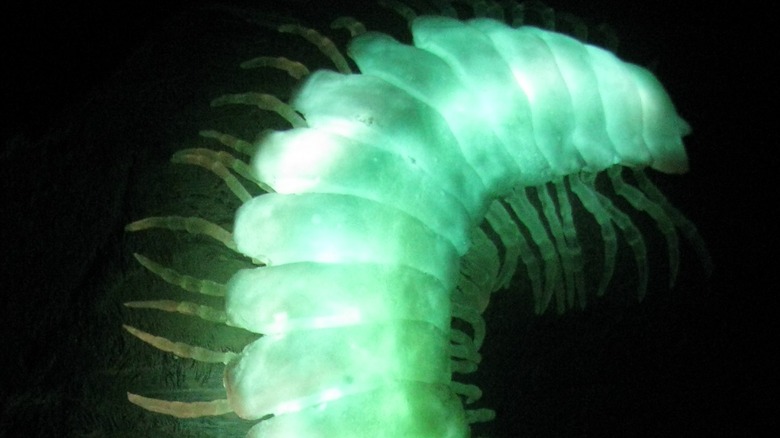The National Park That's Covered In Glowing Millipedes
During the day at Sequoia National Park in Central California, it's the ancient giant redwood trees that are the headliners, but on moonless nights, it's what you'll find on the ground that are the real stars (they even provide their own stage lights of sorts). The park, located in Three Rivers, is home to a unique millipede called Motyxia sequoia alia, which gives off an unearthly greenish-blue bioluminescent light, according to Atlas Obscura.
The genus Motyxia — made up of eight species, including those found at Sequoia National Park — are the only known millipedes that glow in the dark, and all live within close proximity to each other in a three-county range in California, per Smithsonian Magazine. "These millipedes actually produce their own light by way of a chemical reaction in their body," Paul Marek, an entomologist specializing in millipedes, told NPR's "Science Friday." Some creatures light up as a way to attract a mate, as is true with fireflies, according to EarthSky. In the case of these millipedes, it's not about attraction but rather repulsion.
A warning to predators
Motyxia millipedes don't have eyes so they can't even see each other light up. The glow is a warning to potential predators. These arthropods produce the poison hydrogen cyanide as a defense against larger creatures. They glow to let birds, mice, and other predators know they're in for a world of trouble if they ingest them. While the millipedes don't produce enough poison to kill predators, they can definitely sicken them. Mice are known to avoid eating them after experiencing a stomach-churning Motyxia dining experience.
In 2011, a team of scientists from the University of Arizona conducted an experiment — published in Current Biology — to see if it was the millipede's glow that helped deter predators. They used both live and fake millipedes, half of which glowed and half of which didn't, and left them in the forest overnight. The live millipedes were tethered to the ground to keep them from wandering off.
[Featured image by Eden, Janine, and Jim via Wikimedia Commons | Cropped and scaled | CC BY 2.0]
Bitter almonds
The results of the experiment showed that the glowing millipedes were attacked less than half as much as those that didn't light up. Paul Marek, who was involved in the University of Arizona study (he's now an assistant professor at Virginia Tech) told "Science Friday," "There are fewer attack marks relative to the non-luminescent ones." According to Marek, this suggests the millipedes' bioluminescence does "deter predators from eating" them.
When not glowing, the Motyxia millipedes have an orange coloration and spend their days buried at the feet of the massive trees in Sequoia National Park, per The Common Naturalist. They come out at night to munch on decaying leaves and other plant matter. The Motyxia millipede is relatively small at a little less than 2 inches long but packs enough poison to emit the telltale smell of bitter almonds, a scent associated with hydrogen cyanide. So be careful if you're out at night looking for the eerie glow of Motyxia sequoia alia in the only national park where they can be found.


